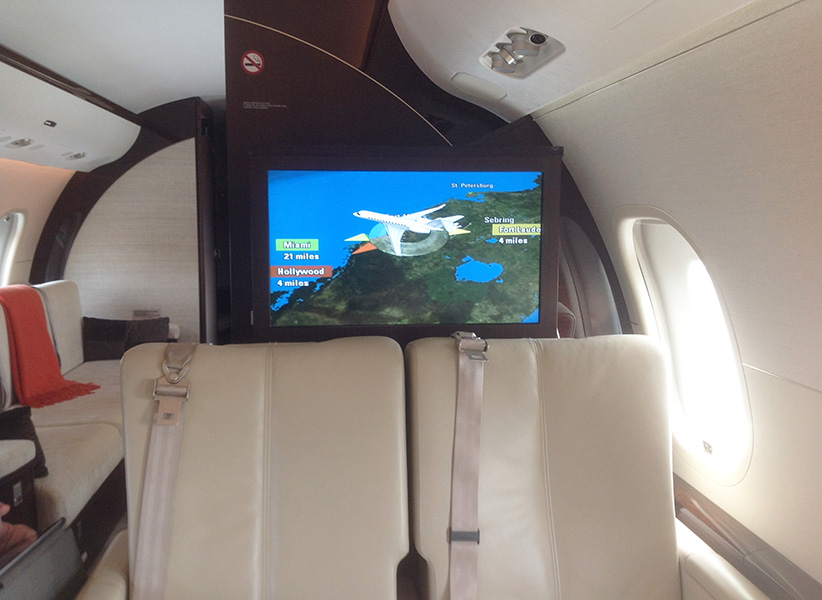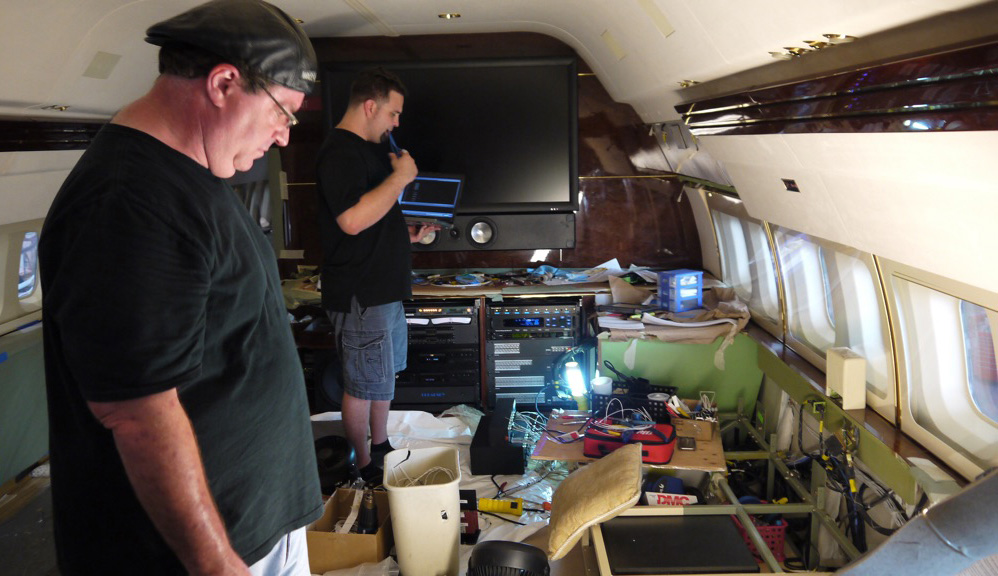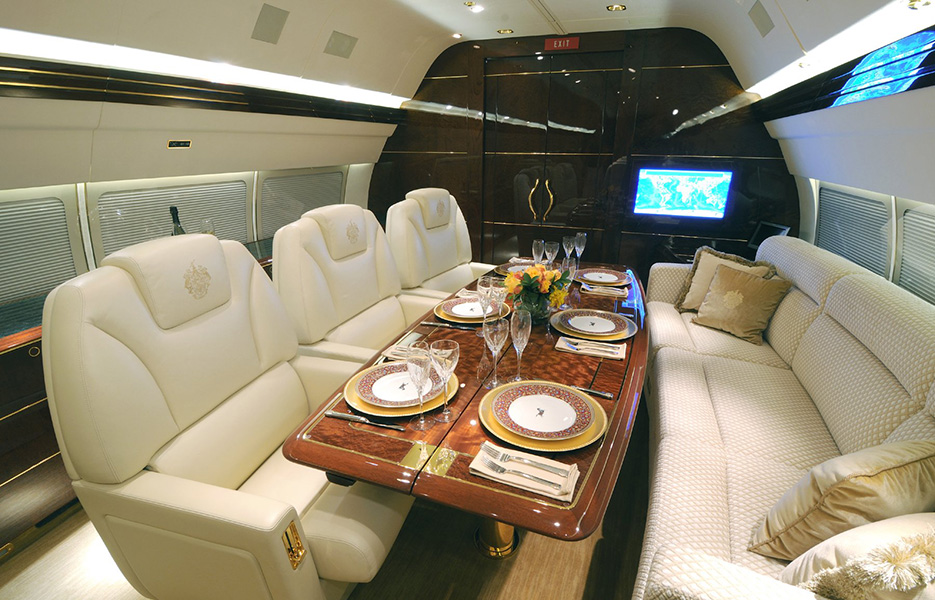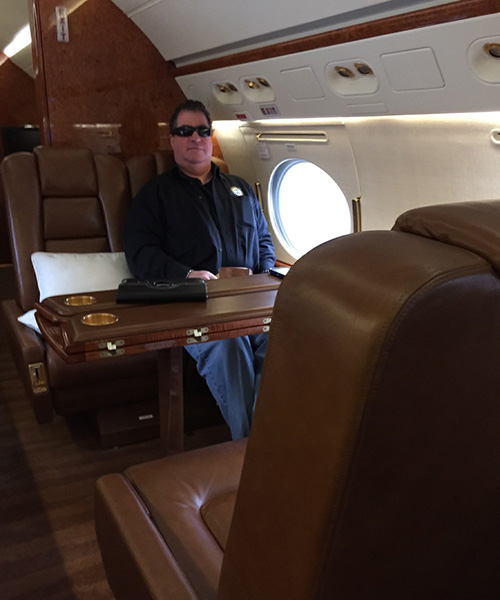CE Pro went behind the scenes with SkyTheater, a company that has become the home control and entertainment specialist for jets like Trump’s Boeing 757. Now that Donald Trump is president, he’s had to abandon his personal jet for Air Force One. But that doesn’t mean it’s an upgrade.
“A Hollywood industry magazine recently called me to ask if Air Force One is better than Trump’s plane,” says Gregg Launer, founder and CEO of SkyTheater. “I said ‘No comment.’”
Gregg and his business partner Andrew Guenther installed an entertainment system of home theatre caliber in Trump’s personal jet back in 2011. They call the project a “point of excellence” for the company, which combines aircraft expertise with an entertainment industry background to create luxury in-flight entertainment.
“The whole experience of working on Trump’s plane changed our world completely,” says Gregg.
Two Passions Come Together
Gregg went to school for broadcast engineering, TV and radio. He got his first job working as an engineer maintaining transmitters at a radio station. Then he joined NBC Miami.
“I was assigned to do interviews with celebrities,” Gregg recalls. “The biggest moment for me was probably when I met Elizabeth Taylor. I think I was 20 at the time. It was there that I learned to be professional around celebrities.”
Gregg also had a dream; he’d wanted to learn to fly since he was young.
“While I was working at the TV station, I had an opportunity to fly in the helicopter,” he says. “I eventually pursued my pilot’s license and my flight instructor’s license. Then I got a job in Florida working with a seafood company that had a Cessna 205, an older aircraft. On weekends I would fly this plane to go pick up lobster tails from the Bahamas. The plane had an old eight-track player, and I decided I would try to improve the sound.”
That was the beginning for Gregg. After improving the sound on eight-track players on a few different planes, he saw his first corporate jet and immediately thought of putting in a sound system or even a theatre. The rest, as they say, is history.
As Gregg began ramping up his business, he met Andrew at a trade show. Andrew had started his own company, then called Advanced Security Systems, installing security systems in high-end homes when he was 17.
“In the late 70s, only the very wealthy had security systems,” says Andrew. “Then around 1980, a customer asked me if I could wire some speakers for him. Back then there were no in-wall speakers. Then I started installing projectors, and Runco came along and we started buying Runco projectors, and it just went on from there.”
Advanced Security Systems became Advanced Audio Design as the business grew to about 80 employees and $20 million a year in revenue. Advanced Audio Design became a premier home electronic installation company in Southwest Florida. Andrew and his team designed and engineered the installation of many home theaters, lighting systems, control systems, multiroom AV, HVAC and automated blinds.
“Then the economy took a crap on us,” Andrew laughs. “It was around this time that I met Gregg. He started talking about SkyTheater and asked if I wanted to get involved.”
Today, both Gregg and Andrew have been trained at George Lucas’s Skywalker Ranch, home to Lucasfilm’s sound design, mixing and audio post-production facility. Andrew still runs his custom installation company, now named Advanced ESI, and the two are both managing members and part owners of SkyTheater.

A Business Idea Takes Off
The year was 1994. Gregg met Wayne Huizenga, the founder of Blockbuster, and talked him into the idea of building a little movie theatre on Blockbuster’s BAC 1-11 corporate jet.
This was, to put it lightly, a revolutionary idea. Before Gregg started his business, there were no movie theatres or studios in corporate jets. He started to get the attention of Hollywood, as well as immersive sound system companies, Dolby and DTS.
“When I found out that [Blockbuster] was trying to buy Showtime, it dawned on me that the system worked so well, why don’t I try to get a movie studio [as a client]?” says Gregg. “I talked Universal Studios into letting me do their jet. Once I got a studio, it really started to take off.”
SkyTheater was officially created in 1996, and has since become the company of choice for the most demanding private and corporate jet owners, which include A-list celebrities, athletes, Fortune 500 CEOs and entertainment industry executives.
“These aircraft manufacturers were pretty much putting car stereos in these planes, and they still do,” says Gregg. “They were blown away by what we could do.”
Now, a combination of avionics and audio/visual expertise forms the core of the SkyTheater team including AV specialists, pilots, avionics integrators, system designers and computer wizards. SkyTheater does audio, video and control including lighting and shading. Because most standard products made by custom electronics manufacturers aren’t certified for aircraft use, SkyTheater makes many of its own electronics and technology for the planes.
“I had a vision. I put my foot down because I wanted to make sure our vision was going to reach the end, to the day we deliver this to Donald”
“You can’t just put in a regular Vizio TV because of all of the internal workings,” explains Andrew. “You have to make sure that everything is electrically and physically able to pass a certification program before any avionics professional can accept this as legally installable in an aircraft.”
This goes beyond TVs and speakers. Each step in the installation process has to pass rigorous inspection.
“The mounting hardware wouldn’t meet the requirements [for aircraft use],” says Andrew. “The framework wouldn’t, the wiring wouldn’t and the internal electrical circuitry wouldn’t.”
SkyTheater orders panels and parts specifically made for aircraft installation, and uses them to build its own products. The company makes screens, speakers, subwoofers, amplifiers, preamplifiers and video distribution. It also installs movie studio licensed audio and video processors.
“Everything is FAA certified,” says Gregg. “Every piece of equipment that we put in these planes is completely custom made and certified. We are looking for a certain sound result and each cabin is so different, every one has to be measured carefully.”
Gregg says manufacturers that make audio components for airplanes claim they use sound mapping, but he has never met a computer that understands sound the way a human can. “If a computer can’t listen to and enjoy the music, how can it map the sound of an airplane?” he asks.
SkyTheater does branch out and uses some products from the market, like iPads for control. The company also owns the certification for aviation on Kaleidescape.
“We can use some devices from the industry, but if they can’t make the FAA certification, we can’t use the device,” adds Andrew. “It has to work with the electronics of the aircraft.”

Trump’s Home Cinema On His Private Plane
President Trump bought his Boeing 757, registered N757AF, in 2010 from Microsoft co-founder Paul Allen. Rumor has it that back then, he called the plane the ‘T-Bird’ or the eerily prophetic ‘Trump Force One.’ Gregg had eyed the plane back in 1995 when Allen first bought it, when it was in Texas being completed.
When Paul referred the Trump Organisation to SkyTheater, Gregg originally spoke only to the organisation and Trump’s attorneys, who also had an idea in their heads of what they wanted for the plane – one that reflected the kind of technology they had in their homes.
“But I had a vision. I put my foot down because I wanted to make sure our vision was going to reach the end, to the day we deliver this to Donald,” says Gregg. “I knew this was a very large airplane that could easily be made into a beautiful private cinema.”
The Trump Organisation delivered the plane to Georgia and the whole interior was taken out of the airplane and made available for SkyTheater to modify. SkyTheater wanted to emulate the Stag Theater at Skywalker Ranch, starting with powerful sound.
“I specifically remember wanting to install this large subwoofer that was going to fire down the whole length of the cabin,” says Gregg. “Members of the Trump Organisation came down from New York and asked where we’re going to put the subwoofer. They explained that Donald bought the plane because he liked the wooden interior and if the subwoofer disrupted the aesthetic at all, I’d have to find another place for it.
“But I didn’t move it. Two weeks later they came back. ‘You need to find another place for this sub,’ they said. I still didn’t move it. ‘He won’t like where it’s going,’ they said. But I stood my ground. I told them, ‘That’s where I’m putting it.’”
Twenty minutes later, Gregg received a phone call from a number he didn’t recognise – with a New York area code.
“Is this Gregg Launer?”
“Sure is.”
“Gregg, this is Donald J. Trump.”
Trump asked Gregg what he thought of his plane, and Launer replied, “It’s the greatest thing Boeing ever built.”
Gregg told his new high profile client that Trump’s decision not to have a TV in the bedroom was “a stupid idea – what if [Trump’s son] Barron wants to play video games on the big TV in the theatre? Are you going to stop what everyone is doing so he can play video games? And furthermore, are you going to let Barron interrupt you and Mrs. Trump in the bedroom?”
Gregg decided to take the third room of the plane and turn it into a video game room for Barron. Trump was very pleased.
As for the subwoofer, it stayed put right where it was.
“This gave me new energy,” says Gregg. “The job was to deliver this aircraft to perfection.”

Presenting The Plane To Donald Trump
Completing the T-Bird took eight months. The crew worked 18-hour days from October 2010 to May 31, 2011 to deliver the perfect finished product, says Gregg, who remembers the delivery just as well as the vision he had at the start of the project.
“We get to New York and there’s a party at Trump Plaza,” says Gregg. “Many people who worked on the airplane were going to the party, but I stayed behind to make sure the system was working for the next morning. It was more important for me to impress him.”
The only thing left to decide was what movie Gregg would use to demo the theater when Trump boarded the plane.
“Everybody expects Star Wars or Raiders of the Lost Arc,” he says. “But I picked a movie from 1959 called North by Northwest, something no one would expect to have great audio.”
Trump invited everyone in to see the demo – members of his organisation and even the New York Post and New York Times.
Gregg pressed play and the demo began. “He knows the movie, you can tell,” says Gregg. “He’s watching the demo. In the movie, you see this biplane that’s probably two miles away and starting to circle. The sound of the plane goes over his head, down the length of the cabin and back.”
Trump was ecstatic, says Gregg. He was so pleased with the result that he invited Gregg to join him on a flight to Scotland.
“On the way to Scotland, we started watching movies and testing out the system,” Gregg recalls. “Donald picked up how to operate the touchscreen right away. We flew overnight, and I told him to wake me up if he has any trouble working the system. He was so excited that he woke me up at 7 a.m. to tell me he figured out the whole system, but he wanted to know how to get to the Elton John concert in the Kaleidescape server.
“‘How loud can this go?’ he asked. ‘Very, very loud,’ I said. And people were sleeping!” Gregg laughs. “But he wanted to turn it up all the way. He said, ‘Let’s wake them up, they need to see this great airplane.’”
When the pair arrived in Scotland, Trump invited Gregg to his golf course and the flight crew went to go pick up Melania. By the time Gregg and Trump joined Melania on the plane, she had figured out the whole system with no trouble at all.
“To this day, we’ve never had one service call about the system,” says Gregg. “I couldn’t be more proud of this project.”
When Gregg discusses Donald Trump’s plane, he never talks about money, he says. He talks about art. This, Gregg says, sets SkyTheater apart from the two industries – custom installation and custom aircraft –that the company brings together.
SkyTheater sees the personal jet as an untapped living room, and they’re as frustrated as any custom installer would be to see the equivalent of car stereos in an otherwise high-end, luxury space.
“If somebody spends $30 million on a house, they’ll spend $1 million on their home theater. When you’re spending $65 million on a jet, are you really going to put in a couple little speakers and call it an entertainment system?” Gregg asks.
“The average amount you’re going to spend with an aircraft manufacturer is $600 thousand to $1.2 million. We’re not even close to that,” explains Launer. “We weren’t looking through Donald Trump’s pocket. We were looking through his eyes and his ears. We never came close to the aircraft manufacturer price.”
The ability to bring custom installation expertise to aircraft projects makes all the difference for SkyTheater. Musing on that very first demo he presented to Trump in New York, Launer expresses a sentiment often mirrored by the CI industry.
“I’ll use older or even black and white movies because they bring back memories,” says Gregg. “It could have been a drive-in, a first date, anything. When you bring back memories and bring out emotion, you’ve sold it. Aircraft manufacturers want their dollar, but we want to create an experience.”

Dealers See Sky-High Opportunity
Many integrators work in the luxury home market, and many of their clients have personal jets. The opportunity is there, but usually neither the integrator nor the clients consider expanding a project beyond the home.
Gregg says SkyTheater is the only company that can build a complete theater system on an aircraft and have it certified for flight. SkyTheater have invested over $200,000 in creating the equipment, getting it certified and making it ‘airworthy.’
While this isn’t exactly a category residential integrators can pick up and start working in tomorrow, there is ample opportunity for partnership.
“Home techology integrators can’t legally do these types of installations,” says Gregg. “If a home theatre company tries to do a job on an airplane, the FAA will shut it down and it will receive all kinds of fines. But we can work together.”
Several of Gregg’s clients were referrals by their integrators. When SkyTheater comes onto the project, the three parties can work together to perfect both the in-home installation and the aircraft installation.
“We’re supporting these dealers by coming in as a partner on the project,” adds Gregg. “[Dealers] have room to focus on their clients’ goals and let us work out the specialised avionics and certified equipment. Dealers can count on us to work for their clients.”
This article first appeared on CE Pro.











